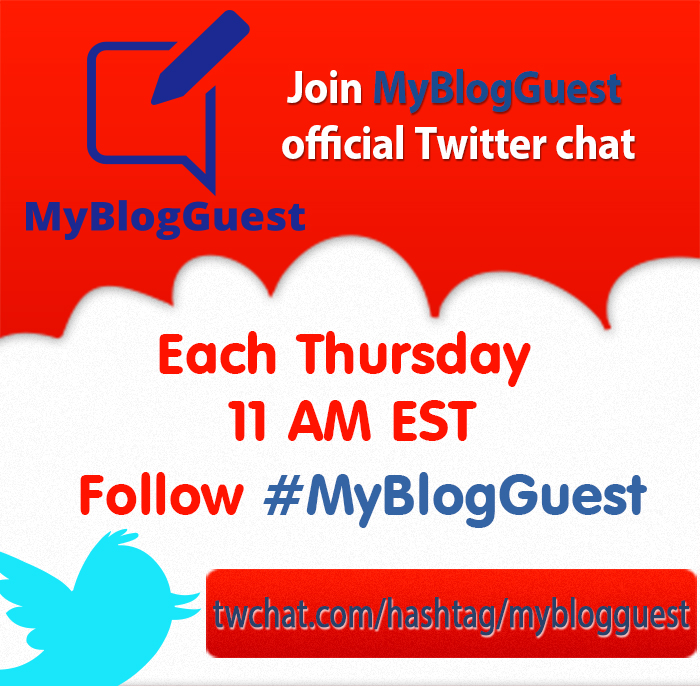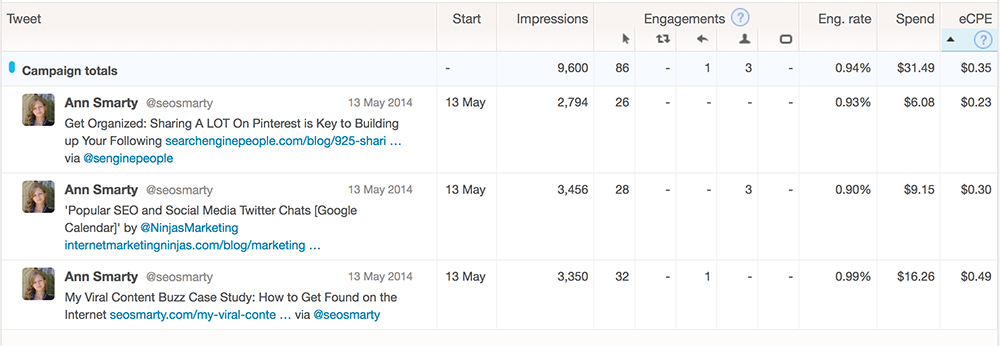 This week we continue our chat sub-series within the “Don’t depend on any one tactic” topic. Our sub-series is dedicated to social media advertising and the first two chats were about Facebook advertising and StumbleUpon ads. Note: We only talk about small (preferably tiny) budgets here.
This week we continue our chat sub-series within the “Don’t depend on any one tactic” topic. Our sub-series is dedicated to social media advertising and the first two chats were about Facebook advertising and StumbleUpon ads. Note: We only talk about small (preferably tiny) budgets here.
Join our weekly Twitter chats here => #MyBlogGuest Twitter chat
Today we are talking about Twitter ads, specifically Twitter “Promoted tweets” (the only Twitter ads section that makes sense for #contentmarketing)
Types
- Keywords: Target searches or users who tweet with words you enter. This is pretty straightforward: You reach people who tweet the keywords or hashtags you specify. This is a good way to reach followers of the popular hashtags.
- Interests and followers: Reach users with interests similar to followers of any of the specified accounts (including YOUR followers). You can *broaden* the targeting by specifying the “interests” [Note this will *expand* the targeted list beyond to followers of the specified accounts]. This type of targeting works good when you want to reach more of your followers or when you want to reach your competitors’ followers.

You can limit either of the above by criteria by:
- Location (highly recommended to avoid clutter)
- Gender (I haven’t tried and that doesn’t make sense in my niche)
- Language (I usually target English-speaking population)
- Devices the people are using (It may make sense in ecommerce where you are mostly interested in mobile phone users, but I never tried it)
I haven’t played with these two yet:
- Tailored audiences (if you have a Mailchimp email list, for example, you can use Twitter ads to reach them more effectively OR you can reach out to your own Twitter lists which you collected based on your Twitter activity. The problem here is that Twitter only works through partners to create audiences, so I haven’t grown big enough yet)
- Television ads (these are used to re-enforce your TV ads which is usually not a small business’s problem; more about conversion settings at @sewatch)
Results
On Twitter you pay for *engagements*: clicks on a Tweet, retweets, replies, favorites, and follows. It is interesting that you pay the same amount of money per engagement: be it a click or a reply or whatever. You have no flexibility here: You cannot for example exclude the engagement type you are not interested to pay for.
@seosmarty Wow. All we've heard is how great it is. If it's not bringing the engagement up…why do it? #myblogguest
— R.C. Lacy (@RC_Lacy) May 15, 2014
@RC_Lacy it does, but not too much (and like we said CLICKS are the highest but absolutely useless metirc) #myblogguest
— Ann Smarty (@seosmarty) May 15, 2014
Important note: “The Clicks engagement type is the clicks to your tweets, not on the outbound links in them” that makes it more or less useless metric (what value does a click to a tweet add to your campaign?)
I haven’t tried Twitter advertising with huge budgets. With micro-campaigns ($20-$50 per campaign) expect to see no more than 10 interactions (follows, retweets, replies) and around 100 clicks. Yes, the numbers vary dramatically depending on types of content you are promoting and targeting settings you have but don’t expect anything overwhelmingly huge from micro-campaigns.
Here are a few case studies with small budgets:
- A $50 Twitter Ads Case Study by @JayCeeEm
- Hands-on Twitter Ads Efficacy Case Study by @enerica
- Are Twitter Lead Gen Cards Worthwhile? Here’s My Case Study by @GabGoldenberg at @NinjasMarketing
- I shared some screenshots at @DevSEOchat forum. Here’s the thread
One good thing about Twitter ads (a later addition to the offering) is so called “eCPE” (if you had a chance to visit our previous chat, that’s something similar to “Earned clicks” in StumbleUpon promotions).
eCPE is “*Earned* Cost Per Engagement” and, in simple words that’s how much you saved from “earned media engagment statistics” which stands clicks, retweets and replies that stem from a retweet you paid for. In simpler words, that’s how much engagement your campaign earned that you didn’t paid for. In my mind that’s a good way to measure “virality” of each tweet (its ability to spread further). The higher eCPE, the more ads like this you’d want to run. A smart use of hashtags (steal some in IM niche) should be a good way to increase your eCPE
Again, if you are like me (and the point of this whole series is to show you the way to try some ads on smaller budgets; we are not talking about huge campaigns here), micro-campaigns on Twitter are not able to drive you huge amount of clicks and interactions (unlike StumbleUpon ads).

The smartest ways to approach Twitter advertising on the tiny budget:
- Combine them smartly with Facebook advertising to reach your target audience on both (=yields higher response rate). If you were doing a good job combining your efforts on Twitter and Facebook (i.e. inviting your page FB fans to follow your brand on Twitter and vice versa), by promoting the same content to your FB fans and Twitter followers (remember “Interests and followers” where you can advertise to your own Twitter followers only), you’ll be able to reach them better and build #beeverywhere illusion.
I guess some of FB versus Twitter response depends on audience and topic? #myblogguest
— Don Sturgill (@Don_Sturgill) May 15, 2014
Absolutely, but Twitter effectiveness is lower across the board RT @Don_Sturgill: FB versus Twitter depends on audience+topic? #myblogguest
— Ann Smarty (@seosmarty) May 15, 2014
- Target very well-defined audience (use either keywords or your competitor or your own following plus target by countries)
- Keep an eye on Tweets with higher Engagement rates and eCPE and do more ads like that.
Bottom line: If you have a small budget, don’t spend in on Twitter unless you have a piece of content you really need to push forward and do other social ads as well. Also, Twitter advertising is reportedly efficient for local ads, but I haven’t tried. Twitter ads are also efficient to test your content virality.
Good luck!
Joseph
Latest posts by Joseph (see all)
- Chatting Guest Blogging at #Pitchboxchat - December 19, 2018
- How to Collaborate on Content: Co-Create, Interview and Find Guest Bloggers! #BizapaloozaChat - December 5, 2017
- Ann Smarty Talking Influencer Marketing at #BW_Chat Twitter Chat - February 26, 2016

Ryan Biddulph
Hi Ann,
Smart breakdown here. New to twitter ads but I dig the idea to expand my presence. No matter how you cut it, twitter is a volume site. No need to create a deluge of ads, but with folks checking from all over the globe, make sure to hit your different time zones.